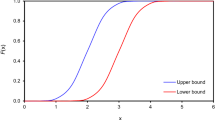Abstract
The paper presents the features of applying the Nassim Taleb’s fragility theory to technical systems and structures. This theory allows analyzing stability and survivability of an object subjected to exceptionally large shock whose likelihood is close to impossible. For example, when an existing integral system (or a set of such systems), designed according to current standards, starts experiencing the impact of loads that have qualitatively changed their nature (for example, due to global climate change). The nature of catastrophes is associated with a strong interdependence of ongoing events. The concept of fragility can be used in risk analysis of technical systems for which loss distribution curves are considered, where losses are described by positive numbers and the right tail of the distribution is considered. Fragility, in the context of the problem under consideration, lies in the incorrect calculation of the risk from large-scale negative events. This is the so-called “simulation fragility”. That is, the systems are “fragile” to inaccuracies in estimating the distribution of stressors, and, consequently, to modeling errors, since this inaccuracy increases the likelihood of loads and impacts exceeding the design limits, leading to a greater likelihood of system failure. Fragility can be used to measure the non-linear response to a change in a model parameter by correlating fragility with model error.
Access this chapter
Tax calculation will be finalised at checkout
Purchases are for personal use only
Similar content being viewed by others
References
Taleb NN (2015) Antifragility. How to capitalize on chaos. LLC “Publishing Group “Azbuka-Atticus”, Moscow
Taleb NN (2014) Silent risk: lectures on fat tails, (Anti) fragility, and asymmetric exposures. SSRN Electron J
Taleb NN, Douady R (2013) Mathematical definition, mapping, and detection of (anti) fragility. Quant Financ 13(11):1677–1689
Bevrani H, Anichkin K (2005) Estimation of the parameters of distributions with heavy tails using empirical distribution. In: Riznichenko GY (ed) Proc of the XII international conference of “mathematics. a computer. education”, vol 2. Scientific Publishing Center “Regular and Chaotic Dynamics”, Izhevsk
Papkov BV, Kulikov AL, Osokin VL (2018) Estimation of probabilities and risk of rare events in the electric power industry. In: Proceedings of the 90th meeting of the international scientific “methodological issues of researching the reliability of large power systems”
Timashev SA (2020) Black-Swan type catastrophes and antifragility/supra-resilience of urban socio-technical infrastructures. IOP Conf Ser: Mater Sci Eng 972:012001
Vladimirov VA, Vorobyov YL et al (2000) Risk management: risk. sustainable development. synergetics. Nauka, Moscow
Arnold VI (1990) Theory of catastrophes. Nauka, Moscow
Alekseev YuK (1990) Introduction to the theory of catastrophes. Finance and statistics, Moscow
Kennie HJ (2014) Engineering antifragile systems: a change in design philosophy. Proc Comp Sci 32:870–875
Author information
Authors and Affiliations
Corresponding author
Editor information
Editors and Affiliations
Rights and permissions
Copyright information
© 2023 The Author(s), under exclusive license to Springer Nature Switzerland AG
About this paper
Cite this paper
Timashev, S., Bushinskaya, A. (2023). Specifics of Applying the Fragility Theory to Technical Systems and Structures. In: Radionov, A.A., Ulrikh, D.V., Timofeeva, S.S., Alekhin, V.N., Gasiyarov, V.R. (eds) Proceedings of the 6th International Conference on Construction, Architecture and Technosphere Safety. ICCATS 2022. Lecture Notes in Civil Engineering, vol 308. Springer, Cham. https://doi.org/10.1007/978-3-031-21120-1_48
Download citation
DOI: https://doi.org/10.1007/978-3-031-21120-1_48
Published:
Publisher Name: Springer, Cham
Print ISBN: 978-3-031-21119-5
Online ISBN: 978-3-031-21120-1
eBook Packages: EngineeringEngineering (R0)




